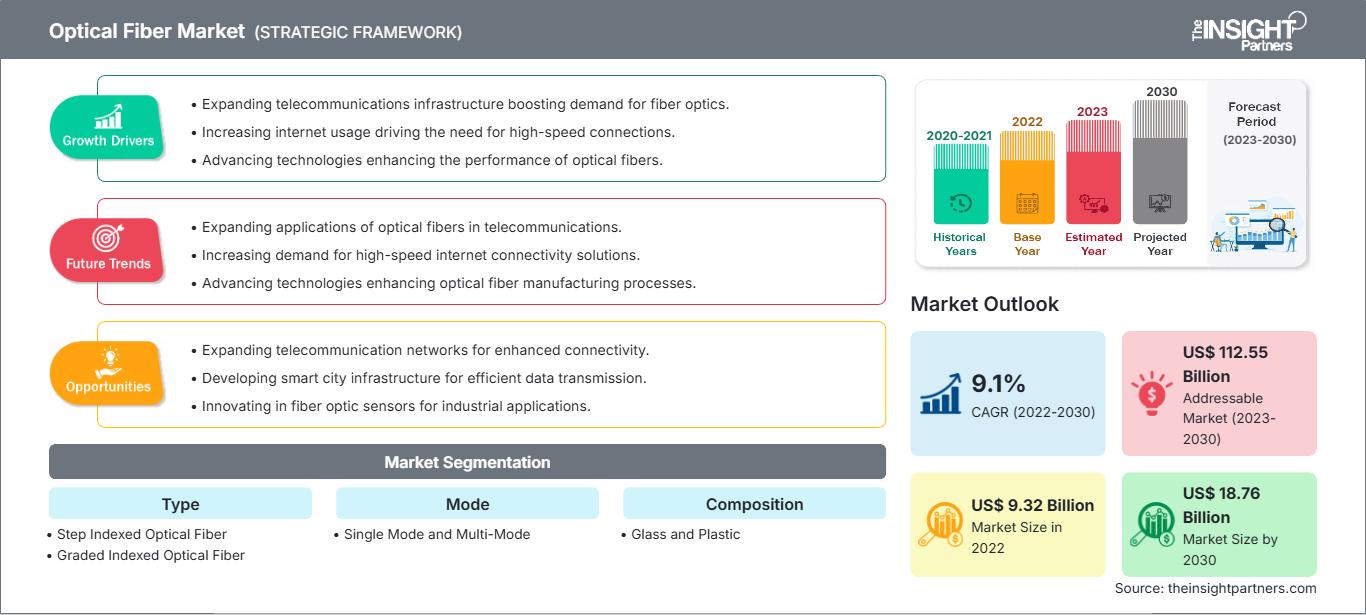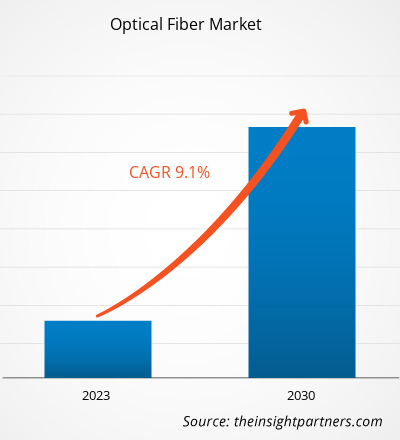光ファイバー市場は、2022年の93億2,000万米ドルから2030年には187億6,000万米ドルに成長すると予測されており、2022年から2030年にかけて9.1%のCAGRで拡大すると見込まれています。高速インターネットの需要増加と通信インフラの発展が、市場の主要なトレンドになると予想されています。
光ファイバー市場分析
光ファイバーネットワークの発展は、消費者のデータ需要の急増とモノのインターネット(IoT)デバイスの急速な普及によって推進されると予想されています。また、世界中の多くの国の政府が光ファイバーの展開に多額の投資を行っており、市場の成長にとって有利な機会を生み出しています。たとえば、米国では、来たる5Gワイヤレスネットワークのサポート、ブロードバンドの競争の促進、および地方のブロードバンドカバレッジの提供のために、今後5~7年以内に光ファイバーインフラを大幅に拡張する必要があります。これにより、光ファイバーケーブルの導入に約1,300~1,500億米ドルの投資が必要になると推定されています。これらの進展は、通信業界の企業が光ファイバーインフラの需要拡大と5G革命によって創出される機会を活用し、光ファイバー市場の成長をさらに促進する大きな可能性を浮き彫りにしています。
光ファイバー市場業界概要
光ファイバーは、非常に柔軟なガラスまたはプラスチック製のファイバーで、光信号を端から端まで伝送することができます。これらのファイバーは光ファイバー通信において重要な役割を果たし、従来の電気ケーブルと比較して伝送距離が長く、帯域幅が広いという利点があります。光ファイバーは信号損失が少なく、金属線が抱える一般的な問題である電磁干渉の影響を受けにくいため、金属線よりも好まれています。通信に加えて、光ファイバーは照明、イメージング、ファイバースコープと同様に、限られた空間への光や画像の伝送などの用途にも広く使用されています。さらに、光ファイバーセンサーやファイバーレーザーなど、さまざまな目的に特殊なファイバーが使用されています。
要件に合わせてレポートをカスタマイズ
レポートの一部、国レベルの分析、Excelデータパックなどを含め、スタートアップ&大学向けに特別オファーや割引もご利用いただけます(無償)
光ファイバー市場: 戦略的洞察

-
このレポートの主要な市場動向を入手してください。この無料サンプルには、市場動向から見積もりや予測に至るまでのデータ分析が含まれます。
光ファイバー市場の推進要因と機会
FTTH(Fiber-to-the-Home)接続の採用増加が市場成長を後押し
従来のインターネット技術は、FTTHの高速で信頼性の高い接続に太刀打ちできません。Fiber Broadband Association(FBA)が実施した調査によると、米国で光ファイバーインターネットが普及している住宅数は2021年に6,000万戸を超え、2020年の約5,400万戸から12%増加しました。さらに、この調査では、米国の世帯の43%、カナダの世帯の60%がすでに光ファイバーインターネットを利用できることも明らかになりました。調査によると、Verizon、AT&T、Lumenなどの大手市場プレーヤーは、ケーブル管理サービス組織(MSO)の上位5社にランクインしており、光ファイバーインターネット接続全体の約72%を占めています。一方、Frontier、Windstream、TDS、ConsolidatedなどのTier 2地域事業者は、拡大の10%を占めました。
5Gインフラの拡大
5Gへの移行とそれに伴うインフラのアップグレードにより、予測期間中に光ファイバーの需要が増加すると予想されます。新型コロナウイルス感染症の流行は、コミュニケーションのパラダイムシフトを引き起こし、より多くの人々がリモートワーク、オンライン授業の受講、デジタルプラットフォームを介した情報ストリーミングを行うようになりました。その結果、世界中で光ファイバーの展開サービスが飛躍的に発展すると予想されます。これにより、5G技術の導入が迅速化され、人々は開発と進歩のためのより高速な接続を利用できるようになり、大きな恩恵を受けるでしょう。したがって、5Gインフラストラクチャの成長により、予測期間中に光ファイバーの需要が押し上げられると予想されます。
光ファイバー市場レポートのセグメンテーション分析
光ファイバー市場分析の導出に貢献した主要なセグメントは、タイプ、モード、構成、およびエンドユーザーによるカバレッジです。
- タイプに基づいて、光ファイバー市場は、ステップインデックス光ファイバーとグレーデッドインデックス光ファイバーに分割されます。グレーデッドインデックス光ファイバーセグメントは、2022年に大きな光ファイバー市場シェアを占め、予測期間中に市場でより高いCAGRを記録すると予想されます。グレーデッドインデックス光ファイバーは、コアの中心から外側に移動すると減少する差別化された屈折率をコアに備えています。光は、媒体を通過するときに、曲線のパスでは中心よりもエッジの方が速く伝わります。グレーデッドインデックス光ファイバーは、シングルモードだけでなくマルチモードにもなります。マルチモードのグレーデッドインデックス型光ファイバーは、ステップインデックス型光ファイバーよりもコア径が大きいため、帯域幅が広くなります。帯域幅が広いため、マルチモードのグレーデッドインデックス型光ファイバーは高速データ転送に使用されます。
光ファイバー市場シェア分析(地域別)
地域に基づいて、市場は北米、ヨーロッパ、アジア太平洋、中東およびアフリカ、南米および中米に分割されています。
2022年には、アジア太平洋地域が最大の光ファイバー市場シェアを占めました。アジア太平洋地域のさまざまな国が、モノのインターネット(IoT)の統合や医療システムの進歩など、スマートシティのプロジェクトに重点を置いた、技術的に高度な環境へのダイナミックなシフトを経験しています。光ファイバーは、リアルタイムのデータ伝送と通信に高速で最小限の遅延を提供することで、これらのプロジェクトをサポートしています。さらに、この地域で光ファイバーコネクタの利用が増えていることは、信頼性の高い高速通信インターフェースを実現する上で不可欠であり、それが市場を牽引しています。
アジアにおける市場拡大の大きな要因の一つは、海底光ファイバーケーブルの利用増加です。ネットワーク容量とスペクトル効率の向上に加え、国家間の接続性も強化されています。信頼性の高い接続と高速データ伝送のニーズが高まるにつれて、海底光ファイバーケーブルの利用頻度は高まると予想され、地域市場の拡大に貢献するでしょう。例えば、アジア・アフリカ・ヨーロッパ1海底ケーブルシステム(AAE-1)は、アジア、中東、アフリカ、ヨーロッパの複数の国を25,000キロメートル以上にわたって接続しています。AAE-1海底ケーブルシステムの配備により、この地域の敷設済み光ファイバーの利用率が大幅に向上しました。さらに、アジア太平洋地域の光ファイバーブロードバンド全体は、住宅用固定回線ブロードバンド加入者ベースのシェアの 85.1% 以上を占めています。
光ファイバー市場の地域別分析
The Insight Partnersのアナリストは、予測期間を通じて光ファイバー市場に影響を与える地域的な動向と要因を詳細に解説しています。このセクションでは、北米、ヨーロッパ、アジア太平洋、中東・アフリカ、中南米における光ファイバー市場のセグメントと地域についても解説しています。
光ファイバー市場レポートの範囲
| レポート属性 | 詳細 |
|---|---|
| の市場規模 2022 | US$ 9.32 Billion |
| 市場規模別 2030 | US$ 18.76 Billion |
| 世界的なCAGR (2022 - 2030) | 9.1% |
| 過去データ | 2020-2021 |
| 予測期間 | 2023-2030 |
| 対象セグメント |
By タイプ
|
| 対象地域と国 |
北米
|
| 市場リーダーと主要企業の概要 |
|
光ファイバー市場のプレーヤー密度:ビジネスダイナミクスへの影響を理解する
光ファイバー市場は、消費者の嗜好の変化、技術の進歩、製品メリットへの認知度の高まりといった要因によるエンドユーザーの需要増加に牽引され、急速に成長しています。需要の増加に伴い、企業は製品ラインナップの拡充、消費者ニーズへの対応のための革新、そして新たなトレンドの活用を進めており、これが市場の成長をさらに加速させています。

- 入手 光ファイバー市場 主要プレーヤーの概要
光ファイバー市場のニュースと最近の動向
光ファイバー市場は、主要な企業出版物、協会データ、データベースなどの一次調査と二次調査後の定性的および定量的データを収集することで評価されます。光ファイバー市場の動向のいくつかを以下に示します。
- コーニング社は、欧州連合および周辺地域で高まる高速接続の需要に対応するため、ポーランドのムシュチョヌに新しい光ファイバー製造施設を開設しました。欧州連合最大級の光ファイバー工場の 1 つであるこの施設は、需要の高まりと顧客の強いコミットメントに支えられ、2020 年以降にコーニング社が世界中で行っている 5 億ドルを超えるファイバーおよびケーブル製造への投資シリーズの最新のものです。(出典: コーニング社、プレスリリース、2023 年 9 月)
光ファイバー市場レポートの対象範囲と成果物
光ファイバー市場の予測は、主要企業の出版物、協会データ、データベースなど、様々な二次および一次調査結果に基づいて推定されています。市場レポート「光ファイバー市場の規模と予測(2020~2030年)」は、以下の分野を網羅した詳細な市場分析を提供します。
- 調査対象となるすべての主要市場セグメントにおける、世界、地域、国レベルでの光ファイバー市場の規模と予測
- 光ファイバー市場の動向、および推進要因、制約要因、主要な機会などの市場動向
- 詳細なPEST/ポーターの5つの力とSWOT分析
- 主要な市場動向、世界および地域の枠組み、主要プレーヤー、規制、および最近の市場動向を網羅した光ファイバー市場分析
- 市場集中度、ヒートマップ分析、主要プレーヤー、および光ファイバー市場の最近の動向を網羅した業界展望と競争分析
- 詳細な企業プロファイル
- 過去2年間の分析、基準年、CAGRによる予測(7年間)
- PEST分析とSWOT分析
- 市場規模価値/数量 - 世界、地域、国
- 業界と競争環境
- Excel データセット
最新レポート
関連レポート
お客様の声
購入理由
- 情報に基づいた意思決定
- 市場動向の理解
- 競合分析
- 顧客インサイト
- 市場予測
- リスク軽減
- 戦略計画
- 投資の正当性
- 新興市場の特定
- マーケティング戦略の強化
- 業務効率の向上
- 規制動向への対応






















 無料サンプルを入手 - 光ファイバー市場
無料サンプルを入手 - 光ファイバー市場